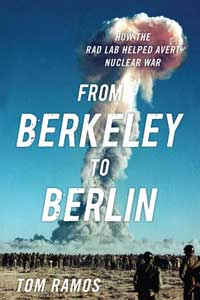Book Review: From Berkeley to Berlin: How the Rad Lab Helped Avert Nuclear War
 From Berkeley to Berlin: How the Rad Lab Helped Avert Nuclear War. By Tom Ramos. Naval Institute Press; https://www.usni.org/; 288 Pages; $39.95
From Berkeley to Berlin: How the Rad Lab Helped Avert Nuclear War. By Tom Ramos. Naval Institute Press; https://www.usni.org/; 288 Pages; $39.95
Tom Ramos’ book, From Berkeley to Berlin: How the Rad Lab Helped Avert Nuclear War, tells the story of how Ernest O. Lawrence, the grandson of a Norwegian immigrant, created a laboratory on the Berkeley campus at the University of California and forced America to awaken to the fact that the Nazi Germany had started to develop plans to build an atomic bomb.
More than 70 years ago, the United States came very close to having a nuclear exchange with the Soviet Union. Ramos writes, “The fact that we escaped, for 70 years, from having a nuclear exchange with the Soviet Union was not an accident.”
Ramos provides a roadmap that takes the reader across multiple decades discussing what America needed to do in order to remain ahead of nuclear threats. There is an abundance of historical information in this book, including about the Manhattan Project, the Berlin Crisis, U.S. President John F. Kennedy, Soviet Communist Party First Secretary Nikita Khrushchev, and the Rad Lab in Berkeley.
The Rad Lab originated in the summer of 1928. At the time, Lawrence was a 27-year-old physics professor who worked at Yale University. He was offered and accepted a position at the University of California’s Berkeley campus in the Lawrence Berkeley National Laboratory, also known as Berkeley Lab.
The book is divided into three parts. Part one is an early overview of Lawrence Livermore National Labs (LLNL) and its significance in research and defense, intelligence gathering, and science. Ramos interfaces historical information as well as writing about Lawrence and his work and dedication advancing the process for developing a fusion bomb. Part two of the book incorporates ideas and strategies concerning the discovery of neutrons, nuclear weapon testing, and a nuclear test moratorium. Part three discusses the leadership that was required and how it inspired America’s leaders to calculate strategies and ideas to develop and refine technology during the first 20-plus years of the Rad Lab.
The history Ramos discusses in this well-written and detailed book offers readers lessons in strategic planning that are applicable even today.
Reviewer: Kevin Cassidy is a professor in the security, fire and emergency management department at John Jay College. He also lectures at Slippery Rock University in Pennsylvania.









